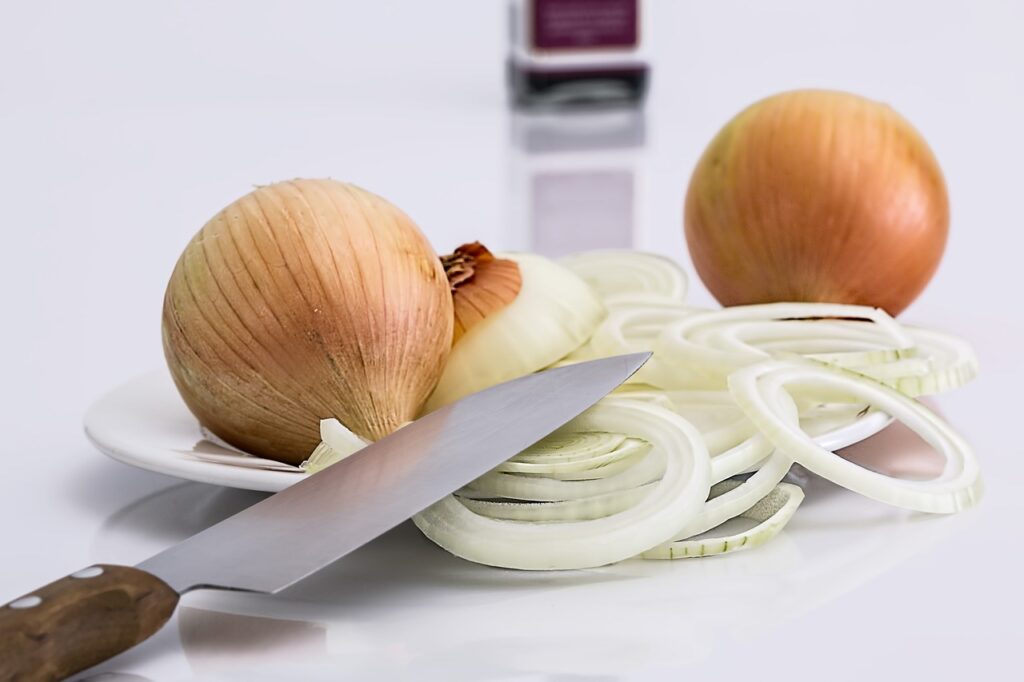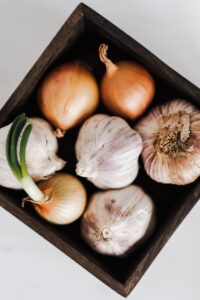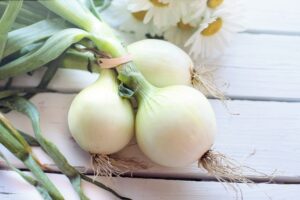
Crying over onions is the most painful point of cooking with onions for a lot of people. However, choosing the right type of onion can make all the difference in the flavor and aroma of your culinary creations. But are yellow onions or white onions considered better for cooking, and why? Let’s explore the nuances of these two popular onion varieties to discover which one reigns supreme in the kitchen.

This image is property of pixabay.com.
Flavor and Taste
Yellow Onions
Yellow onions are known for their rich and robust flavor, making them a popular choice for cooking. They have a strong and pungent taste, with a slight sweetness that enhances the overall flavor of any dish. The flavor profile of yellow onions can range from mildly sweet to strongly pungent, depending on the specific variety and how they are cooked.
White Onions
White onions, on the other hand, have a milder and sweeter taste compared to yellow onions. They have a crisp texture and a delicate flavor, making them perfect for dishes where you want a subtle onion presence without overpowering the other ingredients. White onions are often used in salads, salsas, and dishes that require a more balanced and gentle flavor.
Texture
Yellow Onions
Yellow onions have a firm and crunchy texture when raw, and they soften and become tender when cooked. They hold their shape well during cooking, making them ideal for adding texture to dishes such as stir-fries, stews, and soups. The layers of the yellow onion separate easily, offering a pleasant mouthfeel in various dishes.
White Onions
In comparison, white onions have a softer texture and tend to be milder when raw. They have a crisp bite, similar to that of a mild apple or lettuce. When cooked, white onions also soften but retain a slight crunch, making them a versatile option for both raw and cooked dishes.
Sweetness
Yellow Onions
Yellow onions are naturally higher in sugar content, which contributes to their slightly sweeter taste. When caramelized, the sugars in yellow onions are released, resulting in a rich and sweet flavor that enhances the overall depth of dishes. This sweetness can add a delightful balance to savory recipes and is particularly popular in French onion soup.
White Onions
Compared to yellow onions, white onions have a lower sugar content, giving them a milder taste with less natural sweetness. However, they still impart a subtle sweetness to dishes, especially when cooked. Their mild flavor makes them a versatile option for recipes where you want a more delicate onion taste.
Pungency
Yellow Onions
Yellow onions are known for their pungency and can bring a strong and assertive flavor to dishes. This pungency can vary depending on the specific variety and how they are prepared. The sulfur compounds in yellow onions give them their characteristic bite, which can range from mildly sharp to intensely strong. If you enjoy a prominent onion flavor in your dishes, yellow onions are an excellent choice.
White Onions
White onions have a milder and less pungent flavor compared to their yellow counterparts. They still possess a slight bite, but it is much more subdued. This makes white onions a great option for those who prefer a milder taste or want to avoid an overwhelming onion flavor.

This image is property of pixabay.com.
Cooking with Versatility
Yellow Onions
Yellow onions are incredibly versatile and can be used in a wide range of dishes. Whether you’re sautéing, roasting, caramelizing, or adding them to soups and stews, yellow onions can hold their own in terms of flavor and texture. They pair well with various other ingredients and are commonly used as a base flavoring in many cuisines, making them an essential ingredient in the kitchen.
White Onions
White onions are also highly versatile and can be used for both raw and cooked preparations. Due to their milder taste, white onions are often preferred in dishes where you want a subtle onion flavor without overpowering the other ingredients. They are commonly used in fresh salsas, salads, sandwiches, and mild sauces.
Caramelization Cooking
Yellow Onions
Yellow onions are exceptionally well-suited for caramelizing due to their higher sugar content and pungency. When cooked low and slow, the natural sugars in yellow onions caramelize and develop a deep and rich flavor, with a hint of sweetness. This process intensifies their taste and adds a delightful aroma to a variety of dishes, including French onion soup, pasta sauces, and savory tarts.
White Onions
While white onions can also be caramelized, their lower sugar content may result in a milder caramelization compared to yellow onions. However, their subtle sweetness and delicate flavor can still add a lovely touch to caramelized dishes like onion jam or onion-based sauces.

This image is property of pixabay.com.
Health Benefits
Yellow Onions
Yellow onions are not only delicious but also offer several health benefits. They are rich in antioxidants, including quercetin, which has been linked to reducing inflammation and supporting heart health. They also contain fiber, which aids digestion, and vitamin C, which helps boost the immune system. Additionally, sulfur compounds present in yellow onions have been associated with potential anticancer and antimicrobial properties.
White Onions
Similarly, white onions also provide various health benefits. They are low in calories and fat, making them a great addition to a balanced diet. White onions contain vitamin C, which supports immune function, as well as fiber, which promotes digestion. They also contain antioxidants that may contribute to overall health and well-being.
Regional Preferences
Yellow Onions
Yellow onions are widely used and appreciated in many cuisines around the world. They are particularly favored in Mediterranean, Middle Eastern, and Indian cuisines, where their bold flavor and versatility make them a staple ingredient. The intense taste of yellow onions complements the robust and aromatic spices commonly found in these cuisines, adding depth to the dishes.
White Onions
While white onions are less pungent compared to yellow onions, they also have their regional preferences. They are often popular in Latin American and Mexican cuisines, where their crisp texture and milder taste complement the vibrant flavors of dishes such as ceviche, tacos, and salsas. Additionally, white onions are commonly used in American cuisine for their versatility in salads, sandwiches, and other light dishes.
Availability and Shelf Life
Yellow Onions
Yellow onions are widely available in most grocery stores and markets throughout the year. They have a longer shelf life compared to certain onion varieties, making them a convenient option for stocking up. Stored in a cool, dry place with good ventilation, yellow onions can last for several weeks to a couple of months, depending on their freshness when purchased.
White Onions
Like yellow onions, white onions are also readily available in most grocery stores and markets. They have a similar shelf life to yellow onions when stored properly. Their thinner skin can make them slightly more prone to spoilage, so it’s important to examine them before purchase and utilize them before they start to sprout or become soft.
Price
Yellow Onions
Yellow onions are generally more affordable compared to other onion varieties. Their widespread cultivation and year-round availability contribute to their lower price point. This makes yellow onions a cost-effective option for those who frequently use onions in their cooking or prefer a stronger flavor profile.
White Onions
While white onions are also reasonably priced, they might be slightly more expensive than yellow onions due to factors such as demand and supply. However, the price difference is typically minimal, and both yellow and white onions offer excellent value for their flavor and versatility.
In conclusion, whether you choose yellow onions or white onions for your cooking endeavors depends on your personal preferences and the specific dish you are preparing. Yellow onions bring a robust flavor, pungency, and stronger sweetness, making them an excellent choice for dishes that require a bold onion presence, caramelization, or intense flavors.
 On the other hand, white onions offer a milder taste, slight sweetness, and delicate flavor that works well in raw dishes, lighter preparations, and when you want the onion flavor to be more subtle. Both yellow and white onions are widely available, affordable, and versatile, ensuring you can create delicious meals regardless of your choice. So go ahead and experiment with both varieties to discover your favorite onion companion in the kitchen!
On the other hand, white onions offer a milder taste, slight sweetness, and delicate flavor that works well in raw dishes, lighter preparations, and when you want the onion flavor to be more subtle. Both yellow and white onions are widely available, affordable, and versatile, ensuring you can create delicious meals regardless of your choice. So go ahead and experiment with both varieties to discover your favorite onion companion in the kitchen!

